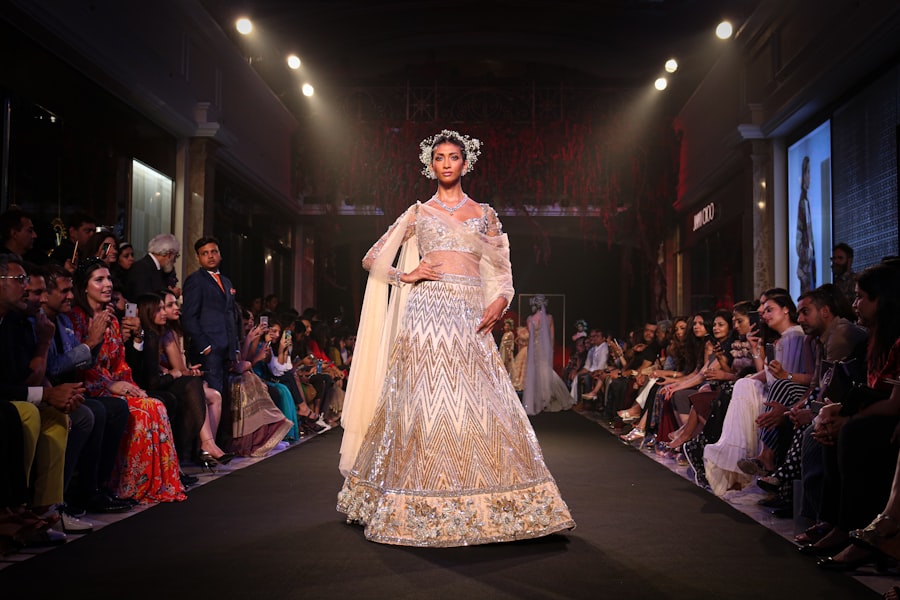The fashion industry is a multifaceted realm that encompasses the design, production, marketing, and retailing of clothing, accessories, and footwear. It is a dynamic sector that not only reflects cultural and societal trends but also influences them. With a global market valued at over $2.5 trillion, fashion is a significant economic driver, employing millions of people worldwide.
The industry is characterized by its rapid pace, with trends emerging and fading in the blink of an eye. This constant evolution is fueled by creativity, innovation, and the desire for self-expression, making fashion a powerful medium for individuals to communicate their identities. At its core, the fashion industry is a blend of art and commerce.
Designers draw inspiration from various sources—art, history, nature, and even technology—to create collections that resonate with consumers. Fashion weeks held in major cities like Paris, Milan, New York, and London serve as platforms for designers to showcase their latest creations, setting the tone for upcoming trends. However, the industry is not without its challenges.
Issues such as environmental sustainability, labor practices, and inclusivity have come to the forefront, prompting a reevaluation of traditional practices and a push towards more responsible approaches.
The Rise of Sustainable and Ethical Fashion
The Rise of Sustainable Fashion
In response to these concerns, many brands are adopting sustainable practices, such as using organic materials, reducing water consumption, and implementing recycling programs. This shift towards sustainability is not only beneficial for the environment, but also resonates with consumers who are becoming increasingly environmentally conscious.
Ethical Fashion and Fair Labor Practices
Ethical fashion is another crucial aspect of this movement, emphasizing fair labor practices and transparency in the supply chain. Consumers are becoming more discerning about the origin of their clothes and the working conditions of those who make them. As a result, brands that prioritize ethical sourcing and fair wages are gaining popularity among socially conscious shoppers.
Transparency and Accountability in the Fashion Industry
The emergence of brands like Everlane and Reformation, which openly share their production processes and costs with consumers, is a testament to the growing demand for transparency and accountability in the fashion industry. Organizations like Fair Trade and the Ethical Fashion Initiative are also working to ensure that workers in developing countries receive fair compensation and work in safe conditions, further solidifying the industry’s commitment to ethical and sustainable practices.
Technology and Fashion: The Future of Retail
The intersection of technology and fashion is reshaping the retail landscape in profound ways. E-commerce has revolutionized how consumers shop, allowing them to browse collections from the comfort of their homes. Online platforms like ASOS and Zalando have become go-to destinations for fashion enthusiasts, offering a vast array of products at competitive prices.
The rise of mobile shopping apps has further enhanced convenience, enabling consumers to make purchases with just a few taps on their smartphones. In addition to e-commerce, technology is transforming the in-store experience. Retailers are increasingly adopting augmented reality (AR) and virtual reality (VR) technologies to engage customers in immersive ways.
For example, brands like IKEA have implemented AR apps that allow customers to visualize how furniture will look in their homes before making a purchase. Similarly, fashion retailers are experimenting with virtual fitting rooms that enable shoppers to try on clothes digitally, reducing the need for returns and enhancing customer satisfaction. These technological advancements not only streamline the shopping process but also create a more personalized experience for consumers.
Inclusivity and Diversity in Fashion
Inclusivity and diversity have become central themes in the fashion industry as brands strive to represent a broader spectrum of identities and body types. Historically, fashion has often catered to a narrow definition of beauty, predominantly featuring thin, white models in advertising campaigns and runway shows. However, there has been a growing recognition of the need for representation across various demographics, including different races, sizes, genders, and ages.
Brands like Savage X Fenty have made waves by showcasing models of all shapes and sizes during their runway shows, challenging conventional beauty standards. Rihanna’s lingerie line not only celebrates body diversity but also emphasizes inclusivity by offering an extensive range of sizes. Additionally, initiatives like the #BlackLivesMatter movement have prompted brands to reevaluate their practices and commit to greater representation of Black designers and models within the industry.
This shift towards inclusivity is not merely a trend; it reflects a broader societal demand for authenticity and representation in all aspects of life.
The Impact of Social Media on Fashion Trends
Social media has emerged as a powerful force in shaping fashion trends and consumer behavior. Platforms like Instagram, TikTok, and Pinterest allow users to share their personal style while discovering new trends from influencers and brands alike. The immediacy of social media enables trends to spread rapidly; what was once considered niche can become mainstream overnight.
For instance, the rise of “cottagecore” aesthetics on platforms like TikTok has influenced everything from clothing styles to home decor. Influencers play a pivotal role in this phenomenon by curating content that resonates with their followers. Brands are increasingly collaborating with influencers to reach targeted audiences authentically.
This shift has democratized fashion marketing; individuals with substantial online followings can now wield significant influence over consumer purchasing decisions. However, this trend also raises questions about authenticity and consumerism as influencers often promote products for financial gain rather than genuine passion.
The Role of Artificial Intelligence in Fashion Design
Artificial intelligence (AI) is revolutionizing various aspects of the fashion industry, particularly in design and production processes. AI algorithms can analyze vast amounts of data to identify emerging trends based on consumer preferences and purchasing behavior. This data-driven approach allows designers to create collections that align with market demands while minimizing waste associated with unsold inventory.
Moreover, AI-powered tools are being utilized in the design process itself. For instance, companies like Stitch Fix employ AI algorithms to curate personalized clothing selections for customers based on their style preferences and feedback. This not only enhances customer satisfaction but also streamlines inventory management for retailers.
Additionally, AI can assist designers in generating new ideas by analyzing existing designs and suggesting variations or combinations that may appeal to consumers.
Fashion and Virtual Reality: The Next Frontier
Virtual reality (VR) is poised to transform the fashion industry by creating immersive experiences that engage consumers in unprecedented ways. Brands are beginning to explore VR technology for virtual showrooms and runway shows that allow customers to experience collections from anywhere in the world. For example, Balenciaga hosted a virtual fashion show where attendees could navigate a digital space showcasing their latest collection.
Furthermore, VR can enhance the shopping experience by allowing customers to visualize how clothing will fit without physically trying it on. Virtual fitting rooms can simulate different body types and sizes, providing a more accurate representation of how garments will look on individual shoppers. This technology not only improves customer satisfaction but also reduces return rates—a significant issue for online retailers.
The Influence of 3D Printing on Fashion Manufacturing
3D printing is revolutionizing fashion manufacturing by enabling designers to create intricate designs with unprecedented precision while minimizing waste. This technology allows for on-demand production, meaning items can be created as needed rather than mass-produced in large quantities. This shift not only reduces excess inventory but also allows for greater customization options for consumers.
Brands like Adidas have embraced 3D printing technology to produce footwear tailored to individual preferences. Their Futurecraft 4D shoes feature midsoles created using digital light synthesis technology, resulting in unique designs that enhance performance while reducing material waste. Additionally, 3D printing opens up new possibilities for sustainable fashion by utilizing biodegradable materials or recycled plastics in production processes.
As the fashion industry continues to evolve through technological advancements and societal shifts towards sustainability and inclusivity, it remains an ever-changing landscape that reflects broader cultural narratives while pushing boundaries in creativity and innovation.








